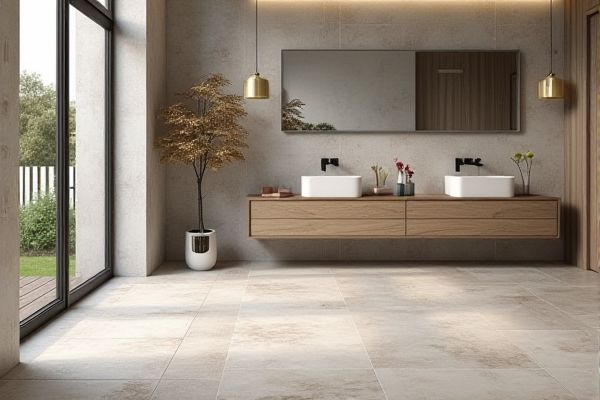
Porcelain tile offers higher density and water resistance compared to ceramic tile, making it ideal for high-traffic and moisture-prone areas, while ceramic tiles are more affordable and easier to cut for DIY projects. Explore the full article to discover which tile best suits Your home renovation needs and budget.
Table of Comparison
| Feature | Porcelain Tile | Ceramic Tile |
|---|---|---|
| Material Density | High density, less porous | Moderate density, more porous |
| Water Absorption Rate | < 0.5% | > 0.5% |
| Durability | Extremely durable, resistant to wear and cracking | Durable but less resistant to heavy wear |
| Cost | Higher price | More budget-friendly |
| Installation Difficulty | Harder to cut and install | Easier to cut and install |
| Best Use | High-traffic areas, outdoors, commercial spaces | Residential indoor walls and floors |
| Finish Options | Glazed or unglazed, wide variety of styles | Primarily glazed, fewer style variations |
| Frost Resistance | Highly frost resistant | Less frost resistant |
Introduction to Porcelain and Ceramic Tiles
Porcelain tile is a type of ceramic tile made from denser clay and fired at higher temperatures, resulting in greater durability and water resistance than standard ceramic tiles. Ceramic tiles are crafted from a mixture of clay and minerals, which are fired at lower temperatures, making them more porous and less durable compared to porcelain. Both tile types are popular choices for flooring and wall applications, but porcelain's enhanced hardness and low porosity make it ideal for high-traffic and moisture-prone areas.
Key Differences Between Porcelain and Ceramic Tiles
Porcelain tiles are denser and less porous than ceramic tiles, making them more durable and water-resistant, ideal for high-traffic or moisture-prone areas. Ceramic tiles are typically more affordable and easier to cut, suitable for walls and low-traffic areas. You should choose porcelain for longevity and outdoor use, while ceramic works well for indoor applications with moderate wear.
Manufacturing Process Comparison
Porcelain tile is made from finely ground clay and fired at higher temperatures, resulting in a denser, more durable surface compared to ceramic tile, which is fired at lower temperatures and made from coarser clay. The manufacturing process of porcelain involves a longer, more precise firing cycle that enhances water resistance and strength, making it ideal for high-traffic or moisture-prone areas. When selecting tiles, your choice between porcelain and ceramic will impact durability, maintenance, and application suitability based on their distinct manufacturing methods.
Durability and Strength
Porcelain tiles offer superior durability and strength compared to ceramic tiles due to their higher density and lower porosity, making them resistant to chipping, cracking, and moisture absorption. This makes porcelain an ideal choice for high-traffic areas and outdoor applications where longevity is crucial. Your spaces can benefit from porcelain's robust performance, ensuring a longer-lasting surface with minimal maintenance.
Water Resistance and Porosity
Porcelain tile is highly water-resistant due to its low porosity, typically less than 0.5%, which makes it ideal for areas exposed to moisture such as bathrooms and kitchens. Ceramic tile has a higher porosity, absorbing more water and requiring a sealant to protect against moisture damage, especially in wet environments. Your choice should consider these differences to ensure durability and prevent issues like mold or warping in moisture-prone spaces.
Design, Color, and Finish Options
Porcelain tile offers a wider range of design, color, and finish options compared to ceramic tile, with its dense composition allowing for intricate patterns and vibrant colors that mimic natural stone or wood. Ceramic tiles are typically glossier and available in a broad spectrum of hues, but porcelain's manufacturing process provides more durable finishes resistant to wear and fading. For your space, porcelain tiles ensure long-lasting elegance and diverse aesthetic choices suited to both contemporary and classic interiors.
Installation Process and Requirements
Porcelain tile requires a more precise and skill-intensive installation process due to its density and hardness, often needing thicker grout lines and specialized cutting tools like diamond blades. Ceramic tile is generally easier to install, as it is lighter and more forgiving when cutting but may require extra care to avoid chipping during placement. Your choice between porcelain and ceramic tiles will affect installation time, required tools, and labor costs depending on the specific application and surface preparation.
Maintenance and Cleaning
Porcelain tile demands less maintenance than ceramic tile due to its denser composition, making it more resistant to stains and moisture. Cleaning porcelain requires only mild detergents and water, while ceramic tile grout may need more frequent sealing to prevent discoloration and mildew buildup. Your choice will influence long-term upkeep, with porcelain offering greater durability and ease in maintaining a pristine appearance.
Cost and Budget Considerations
Porcelain tiles typically cost more than ceramic tiles due to their denser material and durability, making them a long-term investment for high-traffic areas. Ceramic tiles offer a more budget-friendly option without compromising style, ideal for projects with tighter financial constraints. Your choice should balance initial expense against longevity and maintenance to maximize value.
Best Applications: Where to Use Each Tile
Porcelain tile is best suited for high-traffic areas and outdoor spaces due to its dense, low-porosity composition, making it highly resistant to moisture, stains, and wear. Ceramic tile is ideal for indoor applications such as walls, backsplashes, and low-traffic floors where durability demands are moderate and cost-effectiveness is preferred. Both tiles offer versatile designs, but porcelain's superior strength makes it the preferred choice for bathrooms, kitchens, and commercial spaces.
 homyna.com
homyna.com